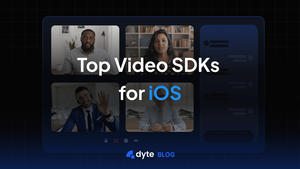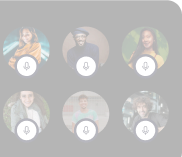In an era where digital communication has become the norm, integrating high-quality video capabilities into your iOS applications is no longer just a nice-to-have feature - it's an absolute necessity.
So why focus on iOS? Apple's iOS continues to be one of the most popular and influential mobile operating systems globally. With its intuitive interface, robust security, and the sheer prestige associated with Apple's brand, iOS boasts a vast and loyal user base. This makes it a prime platform for app developers looking to reach an engaged and tech-savvy audience.
But how easy is it to integrate video SDKs into iOS apps? The good news is that with the right tools and resources, it's not as daunting as you might think. There are numerous video SDKs available that are specifically designed for iOS, each offering a unique set of features and capabilities. Whether you're looking to enable peer-to-peer video calling, live streaming, or video conferencing in your app, there's likely an SDK out there that can make your vision a reality.
In this blog, we'll explore some of the top video SDKs for iOS, their key features, limitations, and pricing models. We'll also provide some practical tips for integrating these SDKs into your iOS apps, making it easier than ever to enhance your application with dynamic video capabilities. Stay tuned!
Must have features in a Video SDK for iOS
When it comes to choosing a Video SDK for iOS, there are several key Video SDK features that you should look for to ensure a high-quality and seamless video experience. These include:
- Real-Time Capabilities: This is a crucial feature that allows for live communication between users, making interactions more engaging and personal.
- Low-Latency Streaming: Low latency ensures that there is minimal delay during video streaming, providing a smooth and real-time experience for users.
- Screen Sharing: This is particularly useful for apps that require collaboration or presentations, as it allows users to share their screens during a call.
- Recording: The ability to record video calls is important for users who may need to review conversations later or keep them for record-keeping purposes.
- Peer-to-Peer and Group Video Calling: This feature allows for both one-on-one and group calls, making the app versatile for different communication needs.
- Mute and Camera Toggle Buttons: These provide users with control over their audio and video settings during a call, enhancing privacy and convenience.
- Background Replacement: This feature allows users to change their background during a video call, which can be useful for maintaining professionalism in a variety of settings.
- Advanced Video and Audio Customization: Some SDKs provide raw data that can be processed for advanced customization, allowing developers to create a unique user experience.
- Robust API and SDK Documentation: Comprehensive documentation is essential for developers to effectively integrate and use the SDK.
- GDPR Compliance: Ensuring the SDK is compliant with data protection regulations is crucial for user trust and legal reasons.
Remember, the best Video SDK for your iOS app will largely depend on your specific needs and goals. So make sure to thoroughly research each SDK and consider these features before making your decision.
List of Top 10 Video SDK Platforms for iOS Apps
- Dyte
- Zoom SDK
- Sinch
- MirrorFly
- Daily
- Mux
- EnableX
- Agora
- Cometchat
- Whereby
Dyte
Dyte is a live video API that is designed to be fully customizable, scalable, and easy to use. It's a modern solution aimed at developers looking to incorporate real-time video interactions into their web or mobile applications. The platform is built with the premise of making live video integration a hassle-free experience for developers, hence providing a comprehensive tool that caters to a wide range of video-related needs.
Features
- High-quality, real-time video and audio streaming capabilities, facilitating seamless communication.
- Screens, whiteboarding, polls, chat, and other interactive features during a call to help teams with collaborative work.
- Recording options for calls, which can be useful for reviewing meetings or for record-keeping purposes.
- Minimal delay during video streaming, ensuring smooth and real-time communication.
- Ready UI kit lets developers customize the user interface to match the look and feel of their own brand or application.
- Allows users to connect via a normal phone call
Dyte Pricing
Dyte's pricing is pretty straightforward; it starts with 10K free credits each month, ideal for startups, small businesses, hobby projects, and developers who are just starting out or testing the platform.
Once these are exhausted, you pay $0.004 per user per minute, with recordings and RTMP-out available at $0.010 and $0.015 per minute, respectively.
If you are looking for custom pricing or volume discount, talk to our team, and we'll figure something out.
Zoom SDK
The Zoom Video SDK is an extension of its video calling app. It lets developers build on Zoom's video, audio, screen sharing, chat, and data stream services based on their requirements.
Features
- It supports custom video layouts.
- Server-side APIs and Webhooks are available.
- Has other basic features, including bandwidth management
Limitations
- Customization options are only available for in-session chat, third-party live streaming and call layout management.
- Allows for the roles of hosts and participants, limiting its flexibility for different use cases.
Pricing
The Zoom Video SDK offers 10,000 minutes per month for free, after which the cost is $0.31 per user minute. There are additional costs for recordings ($500 per month for 1TB of storage) and telephony ($100 per month). Developer support plans are also available at varying costs: Developer (free), Bronze ($675), Silver ($1,300), and Gold ($1,900).
Learn more about Zoom SDK pricing, alternatives, and an honest feature-based comparison of Zoom vs Dyte on our blog.
Are you suffering from Zoom fatigue after Zoom's video conferencing? We have a list of great Zoom alternatives you can refer to.
Sinch
Sinch SDK is a tool that allows developers to create video communication experiences in mobile, web, and desktop applications. It is compatible with iOS, Android, and JavaScript. Sinch offers decent video quality and voice capabilities.
Features
- Sinch SDK works well with iOS, Android, and JavaScript.
- Enables real-time streaming and broadcasting within applications.
- Low Latency Video
- Facilitates text and multimedia messaging.
- Supports traditional phone calling features.
Limitations
- It can be complex to use and may pose a steep learning curve, especially for beginners or less seasoned developers.
- If coding using a Sinch helper library (SDK), there could be issues if the dependencies are not available and referenced correctly.
- Projects are limited to 800 requests per second across all apps and all endpoints.
Pricing
Sinch's Video SDK for iOS has a usage-based pricing model. For over 2500 minutes per month, the cost starts at $0.002 per minute. For specific and updated pricing, it's recommended to contact Sinch directly.
Mirrorfly
Mirrorfly SDK is a tool that allows developers to integrate video chat capabilities into their iOS applications. It offers chat SDKs and provides a 21-day free trial for voice and video call SDKs. With cloud servers and multi-tenancy support, Mirrorfly SDK facilitates video communication experiences. Notably, it includes a one-time license cost and an on-premise hosting option, providing a chat solution that can be customized to fit a brand's identity.
Features
- 21-Day Free Trial for Voice and Video Call SDKs
- Facilitates the management of multiple tenants within a single instance of the application.
- Customizable chat interface that can be branded as per business requirements, like other platform
- Offers on-premise hosting
Limitations
- The platform can be complex and time-consuming, potentially causing delays in project timelines.
- The lack of detailed documentation makes troubleshooting and implementation more challenging.
- Restrictions in customizing the platform to meet unique business needs may not let you achieve the experience you initially planned
Pricing
Mirrorfly SDK provides a "Pay-as-you-go" plan, allowing businesses to pay for only the services they use. Additionally, there's a "One-time License cost" plan for those who prefer a single, upfront payment. However, specific pricing details are not publicly disclosed. To obtain an accurate pricing estimate based on your specific requirements, it is recommended to contact their team and schedule a demo.
Daily
Daily SDK is a tool that offers developers a live video call API for integrating live video and audio capabilities into their iOS applications. The API allows 1080p HD video calls with screen sharing for any device, as well as recording options, including transcriptions. Daily SDK includes the Daily Client SDK for custom user interfaces and Daily Prebuilt, a video chat widget.
Features
- Offers Screen Sharing, Hand Raising, Breakout Rooms, Whiteboard
- Supports interactive calls with up to 1,000 participants
- Logs for events and software performance metrics
- Allows branding and personalization of the user interface
Limitations
- Limited Customization Options
- Mobile SDKs are still in the beta testing phase and may not be fully stable.
- Some users have reported delays in getting a response from support.
- Some edge cases might not be handled optimally by the tool.
Pricing
Daily SDK offers a free tier with a limited allowance of 10,000 free minutes per month. Once the free minutes are used up, the service operates on a pay-per-use basis. The pricing structure is as follows: $0.004/min/user for video calls, $0.00099/min/user for audio calls, and $0.0012/min/user for streaming. This pricing model allows businesses to pay only for what they use, making it a somewhat cost-effective choice for various applications.
Here is a list of 10 Daily Alternatives.
Mux
The Mux SDK is a tool that offers developers an API to integrate live and on-demand video experiences into their iOS applications. It allows users to broadcast real-time sessions live and stream an on-demand version afterward. The SDK supports the integration of real-time video and live streams into various applications, including web-based, iOS-based, and Android-based platforms.
Features
- Allows developers to incorporate live video into their applications smoothly.
- Facilitates immediate streaming of an on-demand version after a live session ends
- Each call can host up to 100 participants
- Supports integration into various platforms like web-based, iOS-based, and Android-based applications
Limitations
- Users have suggested improvements in UI by introducing different ways of data presentation, such as charts, and making reports more inclusive.
- The price point for Mux encoding is considered high by some users.
- Users have recommended having different pricing tiers for encoding videos across different quantities.
- The tool doesn't automate publish/subscribe strategies; users need to manually create them for each set of users.
Pricing
Mux SDK offers new registrations a one-time credit of $20. After that, it charges $0.004 per minute for real-time video, $0.04 per minute for encoding, $0.003 per minute for storage, and $0.0012 per minute for streaming. Additionally, the platform provides simulcast capabilities for an extra $0.02 per minute and auto-generated captions at $0.024 per minute after the initial set minutes.
Now, if you are searching for a Mux alternative, here's one comparison handy for Agora vs Mux.
EnableX
Enablex SDK is a cloud-based CPaaS tool that offers developers an API to integrate real-time communication capabilities into their iOS applications. It provides some basic features like voice and video calls, text messaging, and file sharing.
Features
- Supports up to 2,000 participants per video conference.
- Provides E2EE and AES-512 encryption for enhanced security.
Limitations
- Users have reported that the documentation could be more detailed.
- The platform does not offer a chat feature.
- Instances of delayed response from the support team have been reported.
- Limited customization options
Pricing
Enablex operates on a flexible pricing model that depends on the number of participants and the duration of the session. Additional charges apply for extra features such as recording, transcription, and live recording. For specific pricing details based on your requirements, it is recommended to reach out to the Enablex team.
Here's a list of the top 10 EnableX competitors.
Agora
The Agora SDK provides a live video SDK that is said to be compatible with multiple operating systems, including iOS. The Agora SDK also includes extensions for AR effects, voice and sound effects, content moderation, and noise cancellation.
Features
- Offers visual experiences.
- Reduces background noise for clear audio.
- Facilitates integration with popular cross-platform frameworks.
- The in-built algorithms adjust the resolution from 96p to 1080p based on bandwidth availability, ensuring continuous streaming.
Limitations
- It can become quite expensive at scale due to its pricing model.
- The integration process might be complex integration and require significant developer effort.
Pricing
The cost of using Agora's API depends on your specific usage. Factors like video quality, number of participants, and call duration influence the final price. If you're new to video calling APIs, reviewing Agora's pricing page will help you understand better.
You can also have a look at our detailed breakdown of Agora's pricing model.
Check out how Agora compares to Dyte.
Cometchat
Cometchat SDK claims to enhance peer-to-peer engagement through video capabilities. The API supports basic 1-to-1 and group video & voice chat and can be integrated into your software ecosystems, including iOS applications. Cometchat provides some tutorials and demo apps to help you understand its functionality, but it's up to you to evaluate if it suits your communication workflows.
Features
- Provides the ability to add one-on-one or group calls
- Allows integration with iOS
- Offers customization capabilities
- Allows to drag and drop chat widget
Limitations
- Customers have reported delays in receiving support responses.
- The UI can be complex, particularly for customers under time constraints.
Pricing
CometChat Video SDK for iOS operates on a subscription-based pricing model. However, specific pricing details are not provided in the sources and would need to be checked on the official CometChat website or by contacting their sales team for more accurate information.
Whereby
The Whereby SDK offers a video conferencing platform with basic features suitable for small to medium-sized meetings. It allows for customization of the video interface using its no-code interface editor, facilitating video calls across platforms like websites, mobile apps, and web products without the need for external links or apps. However, it may not meet the needs of larger businesses or those requiring more advanced features.
Features
- Allows you to customize logos, colors, and buttons on the video interface.
- Enables video calls on different platforms without opening external links or apps.
- Provides a decent video conferencing experience for up to 50 participants.
Limitations
- Customization options are elementary and may not allow a completely custom experience.
- It may not have advanced features such as screen sharing for mobile users.
- The platform has a maximum capacity of only 50 participants.
- Some users have reported problems with the mobile app.
Pricing
It offers a subscription-based pricing model starting at $9.99 per month, which includes up to 2,000 user minutes that are renewed monthly. Once these minutes are used up, there's an additional charge of only $0.004 per minute. For an extra fee of just $0.01 per minute, you can also access cloud recording and live streaming options.
Are you considering a Whereby alternative? Here's a list of top 10 Whereby Alternatives
Comparison of Top 10 Video SDKs for iOS Apps
| SDK Provider | Key Features | Pros | Cons | Pricing Information |
| Dyte | - High-quality real-time video and audio streaming - Interactive features (screens, whiteboarding, polls, chat) - Recording options - Minimal delay - Customizable UI - Phone call integration | - Customizable - Minimal delay - Comprehensive tool - 10K free credits per month | None specified - Contact for custom pricing | 10K free credits per month, $0.004 per user per minute, additional costs for recordings and RTMP-out |
| Zoom SDK | - Custom video layouts - Server-side APIs and Webhooks - Bandwidth management | - Video quality - Server-side capabilities | Limited customization - Roles for hosts and participants | 10K free minutes per month, $0.31/user minute, additional costs for recordings and telephony |
| Sinch | - Video quality - Real-time streaming and broadcasting - Low Latency Video - Text and multimedia messaging - Phone calling features | - Video quality - Cross-platform support | Complex for beginners - Coding dependencies - Rate limits | Variable pricing based on functions and volume |
| Mirrorfly | - 21-Day Free Trial - Multi-tenancy support - Customizable chat interface - On-premise hosting | - Multi-tenancy support - Customization - Chat interface | Complex and time-consuming - Limited documentation - Limited customization | Pay-as-you-go and One-time License cost, specific pricing upon request |
| Daily | - Screen sharing, Hand Raising, Breakout Rooms, Whiteboard - Supports up to 1,000 participants - Event logs - Branding and personalization | - Interactive features - High participant support - Event logs | Limited customization options - Mobile SDKs in beta - Delayed support | 10K free minutes per month, pay-per-use pricing: $0.004/min/user for video, $0.00099/min/user for audio, $0.0012/min/user for streaming |
| Mux | - Live and on-demand video integration - Immediate on-demand streaming - Multiple participant support - Multi-platform integration | - Live streaming - Immediate on-demand streaming | UI improvements suggested - High encoding costs - Lack of pricing tiers | $20 one-time credit, pricing varies per minute for different services |
| EnableX | - Supports up to 2,000 participants - E2EE and AES-512 encryption - Real-time streaming and broadcasting - Text messaging | - High participant support - Security features - Real-time streaming | Limited documentation - No chat feature - Delayed support | Variable pricing based on participants and duration, additional costs for features |
| Agora | - Visual experiences - Noise reduction - Cross-platform integration - Adaptive resolution | - Visual quality - Noise reduction | Can be expensive at scale - Complex integration | Depends on usage, check Agora's pricing page |
| Cometchat | - Online/typing notifications - Drag & Drop chat widgets - Customization and translation - Limited participant support | - Online/typing notifications - Customization - Language translation | Delayed support responses - Complex UI - Rate limits | Pricing based on Monthly Active Users (MAU), visit their pricing page |
| Whereby | - Customizable video interface - No-code interface editor - Decent video conferencing for up to 50 participants - Multi-platform integration | - Customization - No-code editor - Supports up to 50 participants | Limited customization options - Limited mobile features - Reported mobile app issues | Starts at $9.99 per month, additional $0.004 per minute after free minutes |
Conclusion
In the ever-evolving digital landscape, selecting the right Video SDK for your iOS application can be a game-changer. It's not just about integrating video capabilities; it's about enhancing user experience, boosting engagement, and driving growth. Whether you prioritize seamless integration, advanced features, scalability, or cost-effectiveness, there's an SDK out there that meets your specific needs.
Remember, the perfect Video SDK for iOS should align with your business objectives, technical requirements, and customer expectations. From Cometchat's scalable and secure APIs to Whereby's user-friendly video conferencing platform, the choice ultimately depends on your unique use-case scenario.
As we conclude this blog, we hope you have gained valuable insights into some of the leading Video SDKs for iOS in the market. The journey to enrich your iOS application with real-time video communication starts with informed decision-making. So, take your time, evaluate your options, and choose wisely. After all, the future of your app's success depends on it.
If you're curious about what we've done, here are some resources:
Interested? Let's talk and figure out how Dyte can help amp up your software's communication capabilities.




